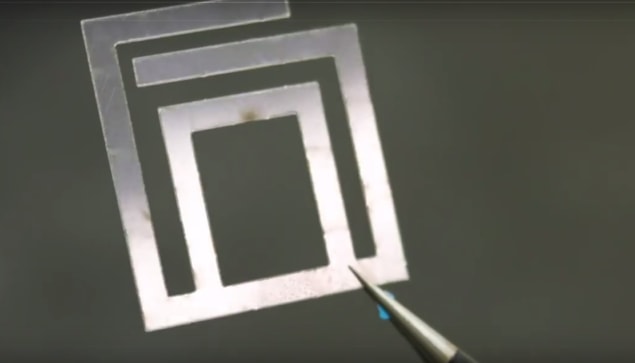
Few people question that 2D materials can do great things, but the real sixty-million-dollar question is what they will actually be used for. While the Nobel prize has recognized achievements in a range of fundamental and applied fields over the years, few have been followed by such an explosion of research activity or such great expectations for fast returns on the investment as the award for graphene in 2010. Interest in graphene has spawned the discovery of a whole brood of 2D materials, each with their own unique claims for making a real-world impact. Developing quick and easy fabrication approaches can be a crucial step between idea and industry, and here a number of recent reports have upped their game.
MXene spray
Two-dimensional materials that have attracted attention since the discovery of graphene include not just lone contributions like phosphorene, silicene and stanene, but also whole families such as transition metal dichalcogenides. In 2011 studies led by researchers at Drexel University revealed the MXenes, a family of 2D transition-metal carbides, nitrides, and carbonitrides with true to form an embarrassment of riches in terms of exotic and potentially useful properties. Now Yury Gogotsi and team at Drexel have demonstrated that by dissolving the MXene Ti3C2 in water they can produce a highly conducting ink or paint. What is more they show that spraying a film of this paint onto a surface can produce an antenna on the surface that can connect to the Internet of Things with no need for additional circuitry. The exceptional properties of the MXene means that a sprayed on Ti3C2 antenna can outperform silver ink by a factor of 200 and even beats graphene by a factor of 50.
MXenes have also attracted interest for capacitors and energy storage and conversion technologies, a potential application that has attracted more than one review. This week Wee-Jun Ong from Xiamen University Malaysia, Neng Li from Wuhan University of Technology in China and colleagues provide a detailed review on the catalytic properties of this class of materials. “Importantly, countless investigations on MXene for photocatalysis and electrocatalysis are progressing rapidly and a game-changing breakthrough in artificial photosynthesis (H2O splitting, CO2 reduction, and N2 fixation) has emerged most recently,” Ong, Li and colleagues explain as they highlight the gap the review aims to fill. After a summary of some of the preparation techniques, and the key structural and electronic properties of these materials they provide an overview of MXene-based catalysis for a number of reactions that are particularly important for not just green energy but also reducing the damage to the environment of certain chemical industries and the combustion engine, including oxygen reduction and evolution reactions, hydrogen evolution reactions, pollutant degradation, and nitrogen and carbon dioxide reduction.
Easy films
Nanfang Yu, Yuan Yang and colleagues at Columbia University in the US have also addressed environmental issues with their passive cooling polymer paint. They show how dissolving the right polymer in the right ratio of water and solvent can produce paint that dries with nano- and microscale and air voids just the right size to optimize reflection of sunlight and radiation of thermal energy to cool surfaces several degrees below ambient temperatures. At several hundred nanometres thick the coatings are far from 2D materials but like the spray on antennas, the ability to paint on the coating rather than having to produce it as a film in factory makes it much more accessible.
The report comes not long after researchers in Spain and Singapore describe a one-pot method for producing ultrathin films of a metal organic compound for flexible 2D electronics. Their films of [Cu2I2(TAA)]n where TAA is thioacetamide are just 4 nm thick and harbour memristive properties. Lead author Miriam Moreno-Moreno suggests the films may find use in fitness wristbands to monitor heart rate, and adds, “The future of 2D flexible electronics will rely on making conducting ultrathin films of materials that are mechanically robust and flexible in a simple but controlled manner.” While no doubt the attention conferred by the Nobel Prize for graphene has helped 2D materials research to take off it may be fabrication technology developments like these that give the commercialization prospects of 2D materials wings.



